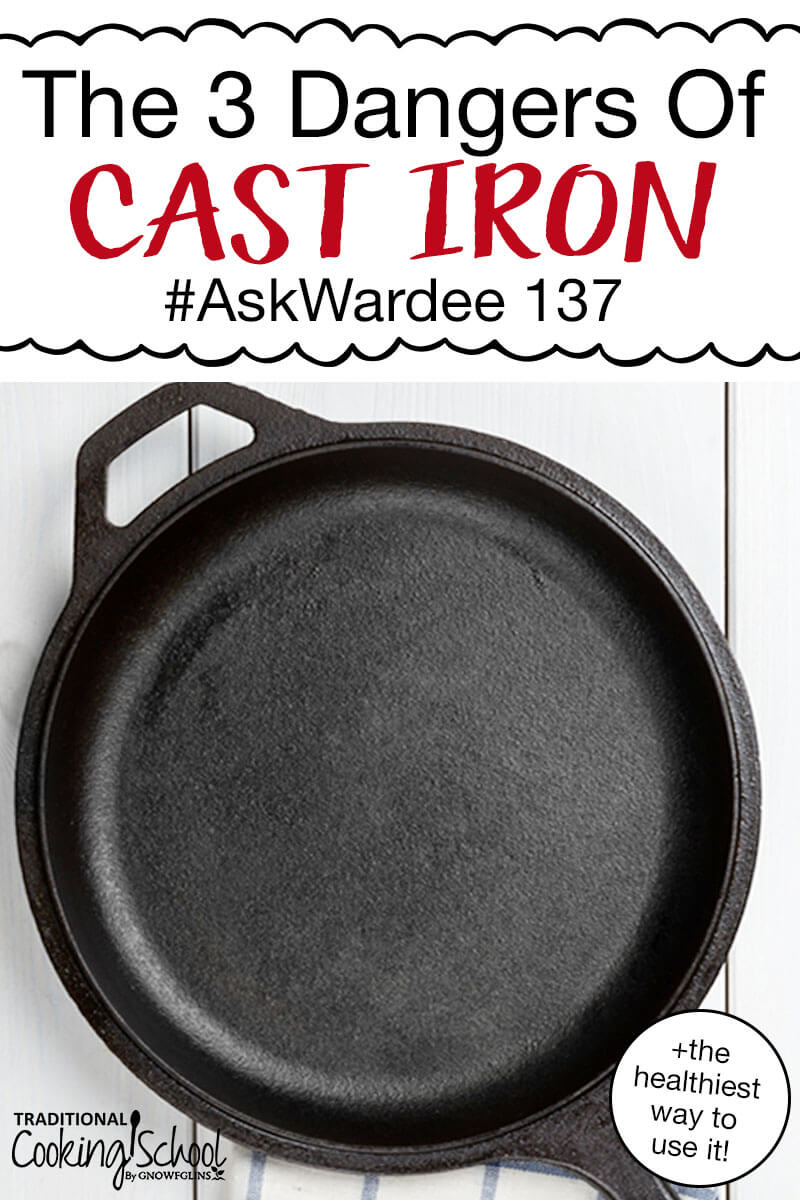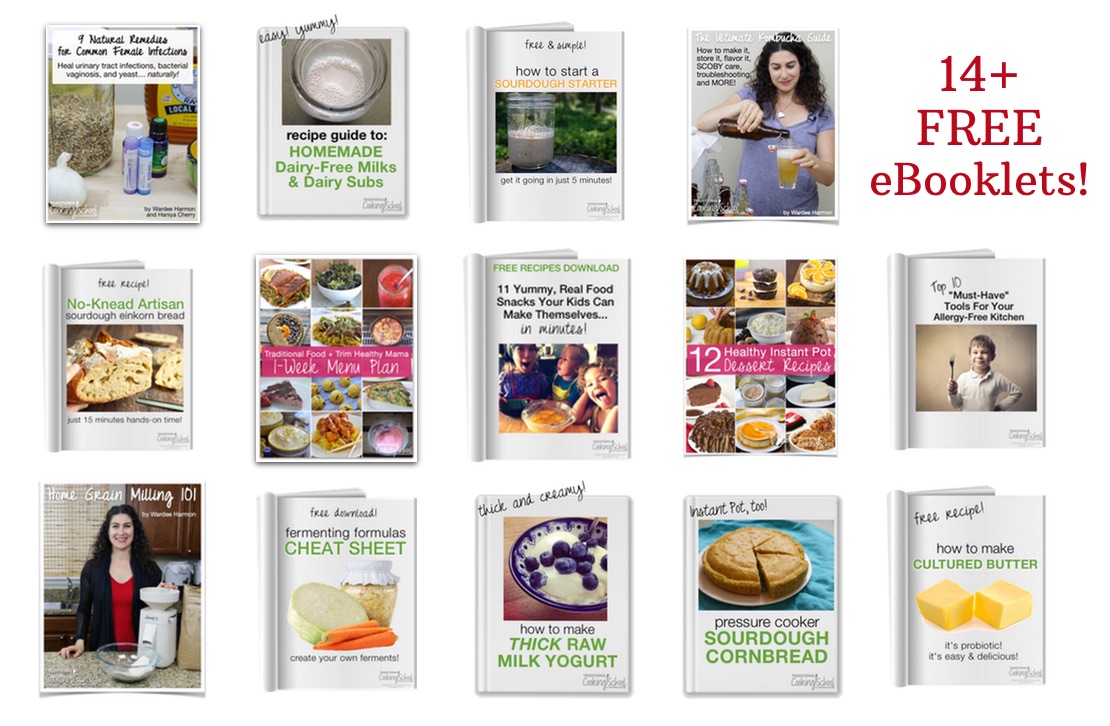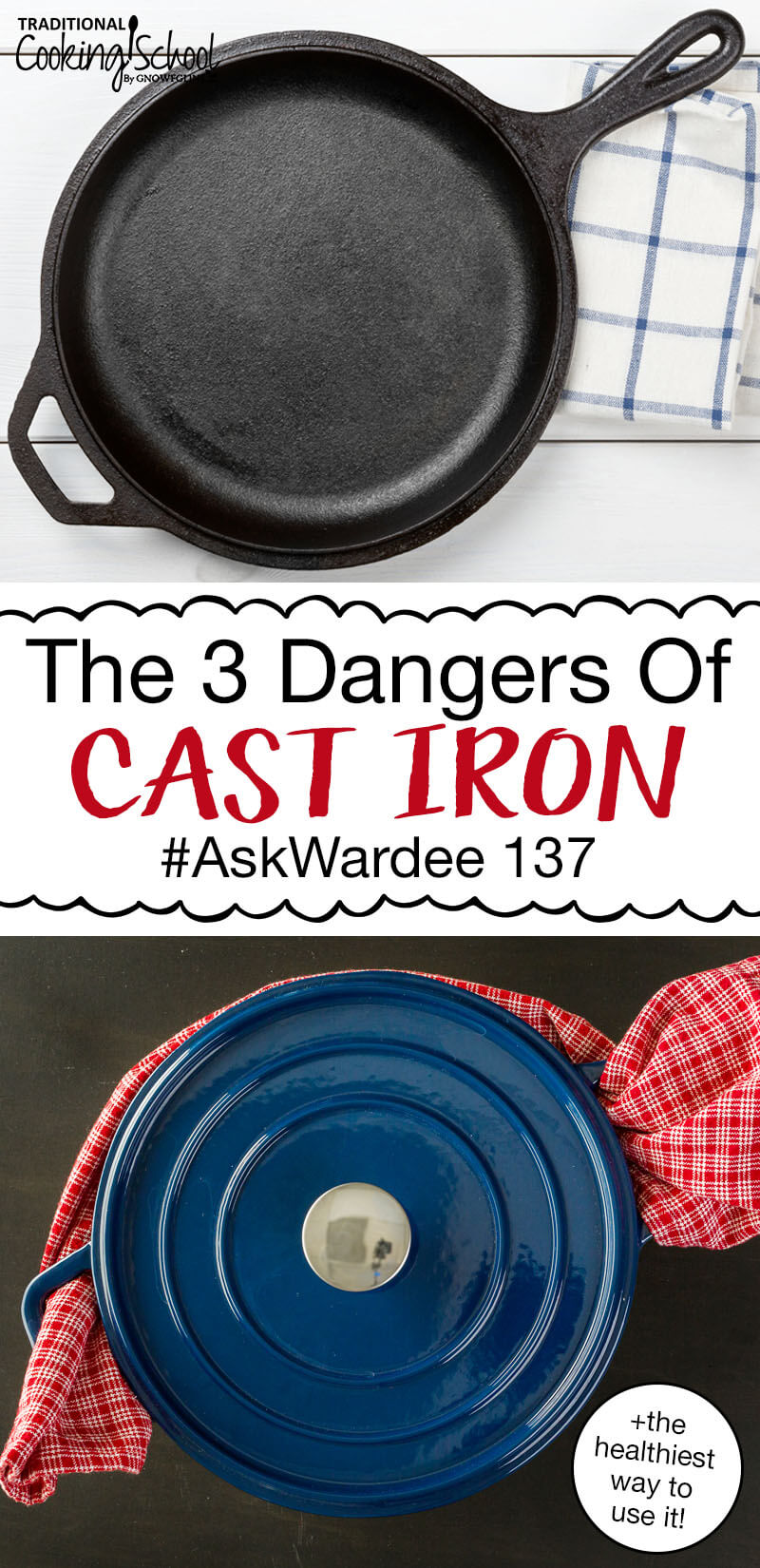Cast iron, cast iron, cast iron… you hear all the time how great it is.
And it really is!
However, there are 3 dangers you should know about… so that you can use it safely and healthfully in your kitchen.
Ruth W. wrote in asking me to address the warnings she’s heard about cast iron and to talk about whether or not enameled cast iron is any better.
I’m happy to share on today’s #AskWardee!
Keep reading or watching below to learn more!
Subscribe to #AskWardee on iTunes, Stitcher, YouTube, or the Podcasts app.
Table Of Contents
The Question: Is Cast Iron Safe?
Ruth W. asked:
Hello Wardee,
I really enjoy listening to your podcasts while working around the house. You have a good combination of food related topics as well as just good life advice and encouragement.
I have a question that I have been thinking about for a bit and was wondering what your thoughts are.
In many traditional cooking resources I have heard that cast iron is a recommended choice of equipment, but I have also heard in a few places that it is not recommended due to the iron that is absorbed by the food.
What are your thoughts on this? Is iron released when cooking? Is that a good thing, neutral or negative?
Also what about enameled cast-iron? As far as I understand it is also a good choice. Is that coating more inert then non-stick coatings?
Thanks so much for your thoughts, looking forward to hearing them! —Ruth W.
Ruth, thank you for your question!
Because we’re featuring your question today’s #AskWardee, you’re getting a gift — a FREE Mini eCourse! Our team will be in contact with you so you can choose which one you’d like!
The Hidden Dangers Of Cast Iron
Cast iron pans are a staple in our kitchen. We have a great way of seasoning them and using them so they act like non-stick pans for eggs, searing meat, and much more.
Yet, there are some ways you don’t want to use your cast iron, so that you can keep your kitchen as healthy as can be.
Here they are…
Danger #1 — Cast Iron May Cause Iron Toxicity For Some Individuals
Cooking with cast iron provides dietary iron via the food that is cooked in it.
This is usually wonderful for menstruating women and growing children.
Menstruating women lose iron regularly through the monthly menstrual bleeding and even worse, may be iron depleted or even anemic. The iron from cooking in cast iron pans may help them maintain levels or improve depleted iron levels.
In growing children, iron is essential for growth, so cast iron is great for them, too.
However, cooking with cast iron may be dangerous for men and post-menopausal women who already have high iron levels, determined through blood testing. Because neither “bleed” regularly, their bodies don’t release iron; what’s in their bodies stays in their bodies.
If they also cook with cast iron, the extra iron may raise their iron levels too high, causing iron toxicity.
In early stages, excess iron causes fatigue, unexplained weight loss, muscle weakness, loss of sex drive, and more. When iron toxicity is severe, a person may get grey skin and develop heart, liver, and blood sugar issues.
(Donating blood is a great way to lessen iron load!)
We have instructions on how to season cast iron here on #AskWardee 062. Our seasoning method is the best.
Rather than oil coating the pan, we actually create a non-stick surface, built up layer by layer, by heating the seasoning oil so hot on the pan that it converts into a hard surface; it’s not even oil any more! It functions like a barrier between the cast iron and the food that’s cooking in it.
I wouldn’t count on it being 100% effective at separating the food, but it is the best seasoning out there in terms of how it functions (like non-stick) and how it potentially prevents iron from getting into food.
This is especially an issue with acidic foods… and I’ll talk about that next.
Danger #2 — Cast Iron Reacts With Acidic Foods
Acidic foods “react” with metals, and cast iron is no exception.
When you cook acidic foods such as tomatoes in cast iron, you end up with more iron in your dish. And the longer the dish is cooked, the more iron ends up in it.
The result? Your food tastes metallic and takes on an unappetizing greyish color.
And, the acidic food can strip some of the seasoning off your pan.
You can mitigate against this by ensuring your cast iron pans are well seasoned as I show you right here on #AskWardee 062. This type of seasoning provides a barrier between the acidic food and the iron itself, lessening how much iron transfers into the pan.
How Much Iron Is Transferred Into Your Food From A Cast Iron Pan?
It’s hard to know the exact amount of iron transferred into the food. It depends on the acidity of the food, the length of time a food is cooked, and how well the pan is seasoned.
More acidic, longer cooking times, and worse seasoning all contribute to more iron transferring into the food.
The more you can optimize each of these factors, the less iron transfers into your food.
I have been unable to find any research suggesting that good seasoning prevents 100% of the iron transfer, though… so the safest option, if you are an individual who needs prevent any iron transference, would be to use an enamel-coated cast iron or another form of cookware altogether (like stainless steel).
Let’s talk about enamel-coated cast iron next…
Danger #3 — Lead & Cadmium Contamination In Enameled Cast Iron
People often talk about how you can use enameled cast iron as a safe alternative to cast iron, when you want to avoid iron transference. That is true, however you have to be very careful because there’s a huge problem with lead and cadmium contamination, especially in brightly colored ceramics.
Cadmium is a known carcinogen. Lead is a known neurotoxin that causes brain damage and it takes the place of calcium in bones, among other things.
This is a big problem for pregnant women, who pass on a large portion of the calcium in their bones to their unborn babies, especially during the third trimester. As calcium transfers to the baby, lead is freed up and transfers to the baby as well.
Unfortunately, the most popular brand of enameled cast iron, Le Creuset, often shows lead and cadmium at very unsafe levels when tested. (Visit Lead Safe Mama for gobs of test results on vintage and modern kitchen items!)
Here is a Le Creuset yellow sauce pan with 19,600 ppm cadmium and 48 ppm lead. And while this one isn’t cast iron, right here you can see a Le Creuset Mixing bowl that tested at 40,700 ppm lead!
For reference, the “safe” level of lead in the U.S. for children’s toys is below 90 parts per million (source). The “safe” limit of cadmium in the U.S. for children’s toys is below 40 ppm (source).
However, since these pots are used for preparing food that will be ingested, are the limits above really safe?
For drinking water (or anything else that could be ingested), the “safe” standard for lead is below 15 parts per BILLION, although many scientists consider water contaminated with lead over 5 ppb to be unsafe (source).
The “safe” standard of cadmium in drinking water is below 5 parts per billion, as well (source).
So… Is Enameled Cast Iron Cookware Safe?
Ideally, we don’t want ANY lead or cadmium in our cookware, or at least we want it to be within safe levels, so since learning this I’m not sure I can recommend any enameled cast iron at this time.
The safest option I’ve found is from Lodge. This blue Dutch Oven tested at 48 ppm for lead and I have one of them (click here for the one I have).
Honestly, I didn’t know about the lead issue when I bought it and I prefer NO lead in my cookware, yet I am glad that it tests lower than other brands.
What’s The Best Cookware?
All in all, I personally love using cast iron. With caveats: seasoned really well and no acidic foods.
I know that the men in our household probably don’t need more iron as we women do, so we also cook a lot with stainless steel to balance it out. Through regular blood tests, we are able to ensure and monitor that iron levels are where they should be for all members of our family.
And after many years of using cast iron regularly, our family has found that cast iron usage is not a problem and is part of our safe diet.
More Info on Cast Iron
- The BEST Way To Season Cast Iron #AskWardee 062
- Why We Love Cast Iron
- What To Look For In Used Cast Iron #KYF 042
More Traditional Cooking Info…
If you haven’t already, be sure to sign up for the FREE Traditional Cooking Cupboard… you’ll get 14+ FREE eBooks featuring recipes, info, and articles on Traditional Cooking School, and a free Traditional Cooking video series!
Click here to grab your 14+ free eBooks and free video series today!
Any Questions Or Comments?
If you have other questions or comments about your own experience in cooking with cast iron safely, be sure to leave them in the comments!
Helpful Links
- FREE 14+eBooks and FREE Traditional Cooking Video Series
- Lead Safe Mama (TamaraRubin.com)
- Lodge Enameled Cast Iron 6 Quart Dutch Oven
- The BEST Way To Season Cast Iron #AskWardee 062
- Why We Love Cast Iron
- What To Look For In Used Cast Iron #KYF 042
What Is The #AskWardee Show?
The #AskWardee Show is the weekly show devoted to answering your niggling questions about Traditional Cooking: whether it’s your sourdough starter, your sauerkraut, preserving foods, broth, superfoods or anything else to do with Traditional Cooking or your GNOWFGLINS lifestyle.
I share tips and resources, plus answer your questions about Traditional Cooking!
The Details
When: Wednesdays at 10am Pacific / 1pm Eastern
Where: Right here at AskWardee.TV or on social media: Traditional Cooking School on Facebook, Traditional Cooking School on YouTube, or @TradCookSchool on IGTV.
Subscribe: Find #AskWardee podcast on iTunes, Stitcher, YouTube, or the Podcasts app. While you’re there, be sure to leave a rating and review!
Want To Get YOUR Question Answered?
Here’s how to submit your question. If we answer it on #AskWardee, you’ll get a gift!
- Tweet your question to @TradCookSchool on Twitter; use hashtag #AskWardee
- Send an email to wardee at AskWardee dot tv — add #AskWardee to your email so I know it’s for the show
Please do NOT add future questions for #AskWardee to the comments of this post because they might get missed!
Do you cook with cast iron? How do you avoid the dangers, like lead in cast iron cookware? Please share your tips in the comments!
We only recommend products and services we wholeheartedly endorse. This post may contain special links through which we earn a small commission if you make a purchase (though your price is the same).





Thank you again for the info. I often need reminders on things.
If you’re not really using enameled cast iron anymore, what do you recommend baking the artisan sourdough bread recipe in?
Hi, Debbie.
Wardee continues to use the Lodge for that bread, or she will ake it in glass loaf pans. She is OK with the Lodge although she is not 100% happy with the lead levels. They are pretty good, just not good enough. 🙂
~ Danielle, TCS Customer Success Team
Would parchment paper be a good barrier for those with enameled cast iron pans, particularly for baking? They are too expensive to just throw away.
Hi Davette,
For baking I think that would work great! 🙂
~Danielle, TCS Customer Success Team
I did not know about the issues with enameled cast iron, so thank you for sharing. I only have one Le Creuset piece that I use infrequently (it’s heavy and can be hard to clean), and I think I’ll just throw it away or maybe use it for a planter (non-food items). Do you think it would be safe to use on the wood stove with water in it as a humidifier? Again, thanks for this informative, useful post! God bless!
Hi, Amy.
I think it would be fine? Not really sure. I would certainly do it if I had a need for that and it would be useful. 🙂
~Danielle, TCS Customer Success Team
I recommend Xtrema cookware. They are 100% ceramic and nothing else. They are durable and affordable. I have been using the same Dutch Oven for three years now, doing naughty things like putting frozen veggies in it then sitting on top of the burner. The finish never dulls and never cracks according to the manufacturer and that has been true for us. They created this line specifically to address the concerns listed above.
Wardee,
I have and have used just about all the different types of pans, and have settled on cast iron, stainless, and high carbon steel. I use the SS for acidic foods, stocks, and sauces, but hate the way it sticks. My new favorite is high carbon steel because of the weight, and the price. What is your opinion of these, and is there still the same leaching possibility as in cast iron?
Hi, Scott.
We don’t know enough about high carbon steel cookware to give an opinion. I’m sorry.
~Danielle, TCS Customer Success Team
Hi,
Thank you for the Info! I was just wondering, when you were testing the Le Creuset yellow sauce pan- was it the outside of the pan or the inside? Because i know that the outside of the pan can contain led and cadmium because of the color- but the inside of the pan is said to contain none. Can you shed some light on this matter? This is what the company says:
From Le Creuset:
“Cadmium and lead are two elements under strict control in the cookware industry. Our position today for the entire production process is to be in compliance with California Proposal 65 which is the most rigid standard in the world for these elements (approx. 10 times lower than “acceptable” limits). Lead is NOT used in our recipes and for cadmium a special anti-acid enamel fritt is used which will not release the cadmium pigment during cooking. Cadmium is used for coloration purposes in achieving bright exterior colors such as Flame and Cherry. The interior enamel which makes contact with food is either sand, white, or black.
Thank you!
Hi, Dan.
The lady who does the testing (Tamara Rubin), tests many parts of the pans and shares the results for each.
For example you’ll see cadmium on both of the white cooking surfaces in these pans (and lead in one of them):
https://tamararubin.com/2019/02/made-in-france-c-2013-yellow-le-creuset-enameled-sauce-pan-15800-ppm-cadmium-a-known-carcinogen/
https://tamararubin.com/2019/02/made-in-france-c-2013-yellow-oval-le-creuset-enameled-cast-iron-casserole-29-17700-ppm-cadmium-a-known-carcinogen/
I have the same Lodge pan, but in red. Is it only the blue one that has lower levels of lead? Since they all seem to have the same color inside the pan, does it matter what color it is on the outside?
Hi, in terms of toxic Chemicals, you said you found that the safest is the blue Lodge enameled cast iron pot. How about the red one? Do you know if that colour is safe as well? Thanks.
Hi Mavis,
I’m sorry we don’t know about the red Lodge cast iron. You can visit Lead Safe Mama’s blog for more information. We have a link to it in the Helpful Links section above or here it is: http://tamararubin.com/
~ Vicki, TCS Customer Success Team
i have new wood cookstove n not happy now fear contaminates in air n food
what you all know on this bc enamel ….?
thanks
Hi, Alisa.
If you mean enamel cookware, I recommend checking the links listed in the article and also researching the brand of cookware you have to see if it has high levels of lead and/or cadmium. If you mean the stove itself the only thing we can recommend is to research that brand as well. I’m sorry.
~Danielle, TCS Customer Success Team
Hi,
Thank you so much for your research and putting this cautionary information online. It’s probably best to mention that even we older folk do need dietary iron (8 mg per day is recommended) assuming otherwise good health and we do all lose some iron from our bodies every day, if not much. A healthy body deals with moderate excess iron consumption by getting rid of it. But of course your advice on how to seal an iron pan properly is very welcome!